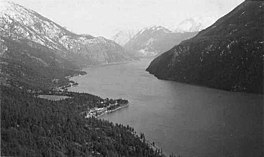Seton Lake
| Seton Lake | |
|---|---|
 Seton Lake from Mission Mountain, c. 1950 Shalalth and Ohin on points at left. Looking west towards Mount Brew and Lillooet | |
 Seton Lake | |
 | |
| Location | British Columbia |
| Coordinates | 50°41′17″N 122°07′35″W / 50.68806°N 122.12639°WCoordinates: 50°41′17″N 122°07′35″W / 50.68806°N 122.12639°W |
| Type | natural lake, reservoir |
| Primary outflows | Cayoosh Creek, Fraser River |
| Basin countries | Canada |
| Surface area | 26.2 km2 (10.1 sq mi) |
| Average depth | 460 m (1,500 ft) |
| Surface elevation | 243 m (797 ft) |
| Settlements | Lillooet, Seton Portage, Shalalth |
Seton Lake[1] is a freshwater fjord draining east via the Seton River into the Fraser River at the town of Lillooet, about 22 km (14 mi) long, 26.2 km2 (10.1 sq mi) in area and lies at an elevation of 243 m (797 ft).[2] Its depth is 460 m (1,500 ft).
The lake is natural in origin but was raised slightly as part of the Bridge River Power Project, the two main powerhouses of which are on the north shore of the upper end of the lake near Shalalth. At the uppermost end of the lake is the community of Seton Portage and the mouth of the short Seton Portage River, which connects Anderson Lake on the farther side of the Portage to Seton Lake.
The Seton Portage River is the main source of natural inflow to Seton Lake, and is primarily fed by Anderson Lake but also by Whitecap Creek, which has its origin on the east slopes of Whitecap Mountain, the highest in the Bendor Range, and by Spider Creek, which has its origin on the north slopes of an unnamed summit to the south of Seton Lake, which happens to be the highest of the Cayoosh Range which lines the south flank of the valley.
The Canadian National Railway (formerly the British Columbia Railway, originally the Pacific Great Eastern) runs along the north shore of the lake.

Prior to the construction of the power project, Seton was considered the bluer and clearer and more brilliant of the two lakes. Afterwards, diversion of the glacial silt-laden waters of the Bridge River into Seton Lake have transformed it into a dull turquoise, and Anderson is now considered the bluer of the two lakes.[3]
The lake was named in the 1860s by Alexander Caulfield Anderson, who traversed the uncharted territory in 1846, after his cousin and boyhood friend, Lt. Col. Alexander Seton, who was drowned in the wreck of the troopship HMS Birkenhead off the South African coast in 1852.[4] In 1858 the route of the Douglas Road incorporated the lake passage.[5]
References[]
- ^ "Seton Lake". Geographical Names Data Base. Natural Resources Canada. Retrieved 2020-06-21.
- ^ "Seton Lake". BC Geographical Names.
- ^ Short Portage to Lillooet, Irene Edwards, self-published, Lillooet, various editions, out of print.
- ^ GPV Akrigg & Helen B Akrigg (1986). British Columbia Place Names. Sono Nis Press. ISBN 0-919203-96-5.
- ^ "Archived copy". Archived from the original on 2011-07-06. Retrieved 2014-08-18.CS1 maint: archived copy as title (link)
| Wikimedia Commons has media related to Seton Lake. |
External links[]
- Lakes of British Columbia
- Reservoirs in British Columbia
- History of British Columbia
- Bridge River Country
- Lillooet Country
- Fjords of British Columbia
